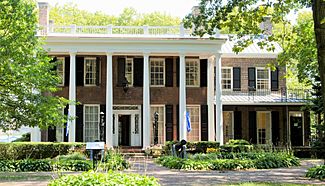Admiral's House (Governors Island) facts for kids
|
Admiral's House
|
|

(2014)
|
|
| Location | Governors Island, New York City |
|---|---|
| Built | main: 1843 south wing: 1886 portico: c.1893-1916 rear: 1936-37 |
| Architect | Martin E. Thompson Charles O. Cornelius (rear) |
| Architectural style | Greek Revival Colonial Revival (portico) |
| NRHP reference No. | 72000860 |
Quick facts for kids Significant dates |
|
| Added to NRHP | July 24, 1972 |
The Admiral's House is a very old and important building. You can find it in the Nolan Park area of Governors Island in New York Harbor. It was first designed by Martin E. Thompson in a style called Greek Revival. The house was finished in 1843. The Admiral's House is so special that it is on the National Register of Historic Places. It is also a New York City designated landmark.
History
The Admiral's House was designed in 1840 by Martin E. Thompson. Its construction was completed in 1843. Later, in 1886, a south wing was added to the house. Between 1893 and 1918, the roof was made taller. A new entrance porch was also added. This porch had Doric columns and was built in the Colonial Revival style.
In 1936-37, the back of the house was changed. An architect named Charles O. Cornelius removed the original pointed roof. He also added decorative ironwork to the building.
What the House Was Used For
For many years, Governors Island was a U.S. Army post. It was known as Fort Jay or Fort Columbus. From the 1870s until 1965, the Admiral's House was called the Commanding Officer's Quarters. Many important generals lived here. These included Omar N. Bradley, John J. Pershing, and Winfield Scott Hancock. Hancock even ran for president while living in the house.
In 1966, Governors Island became a U.S. Coast Guard base. The house was then renamed the Admiral's House. It was officially known as Building 1.
A very important meeting happened here on December 7, 1988. Mikhail Gorbachev, who was the leader of the Soviet Union, met with U.S. President Ronald Reagan. This meeting happened right after Gorbachev gave a speech at the United Nations. The meeting helped the two countries work together. It led to steps that ended the Cold War. The Coast Guard base closed in 1996. This was partly because tensions between countries had lessened.
The Admiral's House was named a New York City landmark in 1967. It was added to the National Register of Historic Places in 1972.
Description
The Admiral's House is two stories tall. It has a high basement on its east side, where the ground slopes down. The first part of the house, built in 1843, looked like a country house. It had special wooden details on the outside. This included a decorative edge under the roof with wavy patterns. It also had porch columns with a crisscross design.
The porches on both the east and west sides have tall wooden Doric columns. The porch on the west side has granite steps. The porch on the east side has a covered area that leads to round brick steps. There are old-fashioned iron lamps next to both staircases. The back staircase also has an iron railing. The south and west sides of the newer south wing also have a porch with iron railings.
A brick path with two cannons leads from Nolan Park to the front door. This entrance is on the western side. The front door has a Colonial Revival style. There are tall windows with shutters on both sides of the front door. The back porch on the eastern side has double doors with small windows above them. The other windows in the Admiral's House have either six-over-six or nine-over-nine panes, and they all have shutters.
See also
 In Spanish: Admiral's House para niños
In Spanish: Admiral's House para niños




